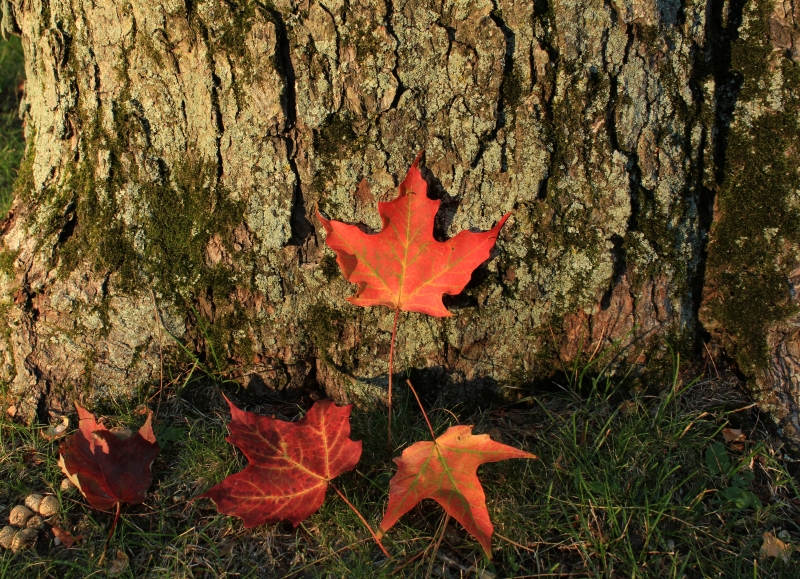
Early Fall Color Changes
Some of my most vivid childhood memories involve plopping into that pile of red, yellow and brown fallen leaves neatly gathered into a mound by my dad. I remember running off the school bus in the golden afternoon sun to roll around in the yard amidst the unforgettable sound of crunching leaves and smell of fall decay. As carefree kids, we thought little of the hard work the trees were doing to prep for winter, or that our fathers did to keep a neatly managed lawn.
Deciduous trees ready themselves for winter through a process called senescence, in which they gradually lose their photosynthetic capability and prepare their leaves to drop off. You may recall that the powerful chemical responsible for photosynthesis in leaves is the green stuff called chlorophyll. Chlorophyll production requires warm weather and sunlight, which is why trees are greenest during the spring and summer. As the days shortern in late summer and fall, trees stop investing energy in chlorophyll production, and it begins to break down in the leaves. At this time of year, you don’t have to look far outside your window to see that chlorophyll is more or less disappearing from the trees in the North Country. All along, chlorophyll has been masking other colorful pigments in the leaves – carotenoids, and xanthophyll - that are present, but not visible, in the leaves all summer long. At this time, some trees begin to produce a third group of compounds, anthocyanins, which are responsible for bright red hues in autumn leaves. Right now you might be starting to hum the song True Colors in your minds as you think about the natural colors of the leaves shining through. I apologize if Cindy Lauper is now stuck in your head for the rest of the day.

With the green chemical responsible for food-production and life now disappearing from the leaves, we can look forward to the peak of fall color going into the month of October. Look for the yellows of sugar maple, basswood, paper birch, American elm, hazel, poplar, ash, aspen, willow; the oranges of cherry and of course the dazzling reds of red maple, dogwood, northern red oak, and staghorn sumac. We’re approaching the time of year where we will be accompanied by a wave of visitors, often referred to as the “Leaf Lookers,” who come to marvel alongside us residents at the colorful show… Let’s enjoy it while it lasts. As the leaves' true pigments are revealed, another chemical, known as abscisic acid, simultaneously dissolves the corky cell layer holding leaves to twigs, and it’s only a matter of time before the breeze finishes the job of defoliation.
Trees are nature’s economists who have learned to calculate the costs and benefits of timing their leaf release over many years. They must balance the need to create energy during the prime summer months against the risk of keeping their leaves too long and suffering frost damage. It’s really a matter of timing things right for a healthy tree to prepare for winter. The process of leaf color change is stimulated by reduced photoperiod, or day length. But temperature and moisture also play a crucial role in the brightness and duration of the fall color show. Warm, sunny days and cool nights are considered to be optimal conditions for vibrant fall colors.

Unfortunately for us, we've had plenty of warm sunny days, but also warm nights and little rain during August and September this year. As early as mid-August, you may have noticed roadside trees around the North Country beginning to turn. By mid-September, some forests patches appeared to be a dull shade of brown. According to the U.S. drought monitor, soil moisture levels in Northern New York have been abnormally low recently. We saw similar conditions in August 2012, when many trees exhibited early color change, and researchers observed record low soil moisture levels. How the recent dry spell will affect peak color this year remains to be seen, but some are predicting less vibrancy in the foliage.
A drought this year could cause ripple effects that influence forest communities in the next few years. Many trees determine how much energy to put towards reproduction, growth, and structure based on the amount of sugar stored in the previous growing season. It's a risky investment for trees to use precious sugar and energy stores toward flowering and seed production because this comes at the expense of other needs for tree survival. In some cases, trees like maples, beeches and oaks might react to drought-like conditions by producing what's called a stress crop, and burn up more of their energy reserves for seed production. If this occurs, it could mean a healthy supply of food for birds and mammals who are readying for winter, but it may also result in much lower seed production the following year with less energy in store. The decision to increase seed production in response to adverse weather conditions all depends on how much energy the tree is willing to allocate towards reproducion if it thinks that it is, literally and figuratively, on its last limb.

Even if we're predicting slightly less showy peak foliage season this year, there is still much to appreciate about a North Country autumn. As you enjoy the fall colors, take some time to give credit to the resilience of these trees who can adapt to changing conditions year after year. Before you know it, this year's “tree-mendous” fall spectacle will be yet another fall memory, and we will look forward to next year’s colorful performance.
***
Want to get outside and learn more about fall colors? Nature Up North is hosting a fall colors hike on the Stone Valley trail in Colton on Saturday, October 10th. Learn more details here.
You can also help contribute to our understanding of the timing of fall color change by participating in our fall maple monitoring citizen science project. To participate, choose a maple tree that you see regularly, and track how it changes throughout the fall, then share your observations here. You'll need to create a free user account on natureupnorth.org in order to participate.

